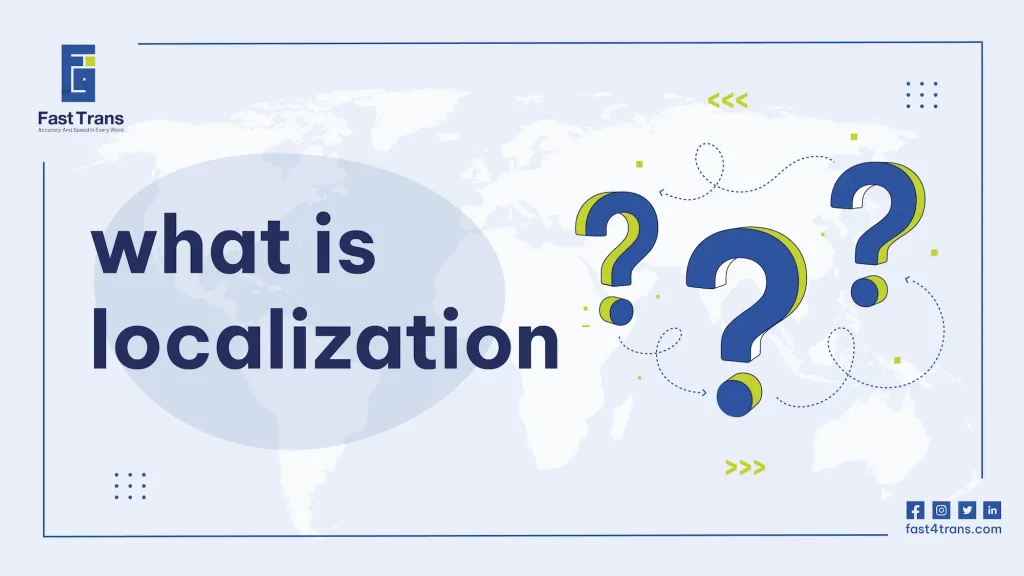What is Arabic localization? Arabic localization goes beyond simple translation by adapting content to fit the cultural, linguistic, and behavioral preferences of Arabic-speaking audiences. It involves adjusting not only text but also images, layout, and design to resonate with local norms and expectations. This process boosts SEO by tailoring keywords and metadata to regional languages, improving search rankings and online visibility. By enhancing user experience and engagement, Arabic localization helps businesses build trust, expand into new markets, and foster stronger connections with local audiences, ultimately driving growth and brand success.
What is Arabic localization?
Arabic Localization is the process that occurs when a translator seeks to adapt the information he is translating to fit the target audience’s linguistic and cultural context.
This definition of Arabic localization extends beyond text translation to include changing the text’s overall style, pictures, symbols, and designs to better fit the target audience’s expectations, culture, and tastes.
The importance of Arabic localization
Arabic localization boosts credibility, brand engagement, and SEO by adapting content to cultural preferences and improving user experience. It enhances search rankings, supports local sales teams, and ensures accurate communication, fostering trust and expanding reach in diverse markets.
1. increase credibility
The process of localizing your website indicates that you respect and appreciate all people from different cultures by translating and localizing the website to suit their ideas and habits.
Some studies also confirm that 60% of people who do not speak English as a native language rarely buy from English-speaking websites only; therefore, major institutions tend to localize their sites in more than one language, which enables them to gain the trust of many target audiences because they are trying to culturally adapt their site.
2. boost your brand engagement
What people are exposed to daily—such as the content they view on social media platforms, websites, and other platforms—has a significant impact on their lives.
As a result, localizing your content for the internet in Arabic across all platforms guarantees that your business reaches a wider audience, which helps to improve the user experience for users in various nations, fosters brand trust, and ultimately boosts sales.
3. Improve search engine results on the internet
Localizing everything on your website, including photographs, videos, files in different formats, and other content, is an important part of making your online presence more localized.
You can enhance your marketing efforts and make them reach a global scale by Arabic localizing the keywords you use in your content, the metadata of the content, the media you use, etc. This will increase traffic to your website from various countries and raise your search engine ranking.
4. Establish a positive brand image
Website Arabic localization gives you complete control over how your brand is communicated to customers in other countries. Localization in Translation considers the cultural sensitivities and preferences of each location to guarantee that the message is understood as meant rather than being twisted by outside businesses or agencies.
5-customize the content for the target audience
Website Arabic localization services make it easy to share customized content with customers in various global markets, where you can control your messages directed online while matching the needs of customers in different regions; enhancing the effectiveness of messages and achieving their goals accurately.
6. support local sales teams
The benefits of localizing sites are not only that they are a great resource for consumers, but they also play an important role in helping sales and support teams located in various countries.
The localized website offers comprehensive details about the goods and services that are unique to this market, that follow national laws and regulations, and that contain all the information needed to communicate with customers and address any issues they may have. This makes it easier for those teams to communicate with the target audience.
read more about Localization glossary
Translation vs Localization
Many people wrongly believe that localization and translation are two separate expressions of the same process, however, in fact, there are significant differences between the two because:
Translation is the process of transferring a text’s meaning and content from one language to another. A translator has to keep the text’s original meaning and spirit while doing so, which may involve interpreting words, phrases, and expressions to fit the target language’s linguistic and cultural structure. The meanings must be done accurately and effectively.
Thus, we can see that localization involves moving content from one culture to another in a way that merges language and culture to create a deeper understanding and a larger impact on the target audience, while translation concentrates on transferring content only from one language to another.
Tips for Arabic Localization
For effective Arabic localization, prioritize cultural sensitivity, adjust SEO strategies with local keywords, and use proper translation to fit regional dialects. Ensure content aligns with right-to-left layouts, local payment methods, and mobile optimization for a smooth user experience.
1. Understand Cultural Sensitivity:
Arabic-speaking audiences value culture-specific references, so ensure your content is respectful and aligns with local customs, traditions, and values.
2. Right-to-Left Layout:
Arabic is written from right to left. Ensure your design accommodates this layout for text, navigation, and images.
3. Language Variations:
Arabic has many dialects. While Modern Standard Arabic is widely understood, consider regional differences in dialects when targeting specific countries or regions.
4. Proper Translation:
Avoid literal translations. Ensure that your content is adapted to the linguistic and cultural context, using professional translation services.
5. Date and Time Formats:
Arabic-speaking countries often use the Hijri (Islamic) calendar alongside the Gregorian calendar. Make sure to format dates and times accordingly.
6. Numerals:
Arabic numerals are used in many Arabic-speaking countries, but some countries use Eastern Arabic numerals (١٢٣٤٥). Ensure consistency with local preferences.
7. Images and Graphics:
Choose visuals that are culturally relevant and avoid images that could be misinterpreted or seen as inappropriate in the local context.
8. Colors and Symbols:
Be aware of the cultural significance of colors and symbols. For example, green is considered a lucky color in many Arab cultures, while others may associate certain colors with different meanings.
9. Local Payment Methods:
Adapt your payment systems to include popular local methods like cash on delivery, credit cards, or digital wallets used in the region.
10. Regulations and Legal Compliance:
Familiarize yourself with local laws regarding online content, advertising, and data privacy. Ensure your localization is compliant with regional regulations.
11. Localize for Mobile Devices:
Mobile usage is prevalent in Arabic-speaking countries, so ensure your website or app is fully optimized for mobile devices.
12. Voice and Tone:
Adjust the tone of your language to suit the local audience—whether formal or conversational. Arabic can vary in formality depending on the target audience.
13. SEO and Keywords:
Optimize your content with relevant local keywords and phrases to improve visibility on Arabic search engines and meet regional search behaviors.
14. Customer Support:
Offer customer support in Arabic, with native speakers available to assist. This helps build trust and ensures smoother communication.
These tips will help create a more user-friendly and culturally appropriate experience for Arabic-speaking audiences.
Types of Arabic localization
Arabic localization covers diverse areas, including software, websites, games, marketing, and apps, each focusing on tailoring content, design, and user experience to suit local languages, cultures, and preferences. These adaptations enhance user engagement and ensure market relevance across Arabic-speaking regions.
1. Arabic software localization
The process of Arabic software localization depends on adapting that software to suit a specific market, as this includes adapting the user interface, the start screen, and other contents that appear in front of the user, such as registration, error messages, and help links, while maintaining the software functions unchanged.
read more about how Software internationalization is done
2- Arabic website localization
The importance of websites is that they are often the first points to introduce your services and products to potential customers in foreign markets, so Arabic website localization is essential to ensure that potential customers enter the site and stay there long enough to learn more about your company and services.
3. Arabic Game localization
To ensure a fun and inspiring gaming experience in all aspects, Arabic localization of games involves modifying images to express the beliefs and ideas of players, as well as translating existing texts in various game parts and converting them to local dialects if necessary.
4- Arabic localization of marketing strategies
Compared to other forms of localization, Arabic marketing localization focuses on fully adapting your marketing strategy to meet its objectives in a particular market. This involves knowing the local culture, customs, and trends to take advantage of in the strategic plan.
5- Arabic App Localization
Pretty similar to website localization. Arabic App localization is for any business big or small that is expanding to other regions that have different traditions, languages, and customs. It’s such a great way to ensure customer satisfaction and earn respect in new markets.
Local Arabic Dialects and Their Differences
Arabic is a language rich in dialects, which vary greatly depending on the region and cultural influences. While Modern Standard Arabic (MSA) is used for formal communication, media, and literature, the local Arabic dialects (known as “Amiya” or “Colloquial Arabic”) are spoken in everyday life across the Arab world. These dialects are often significantly different from MSA in terms of pronunciation, vocabulary, and grammar. Here’s a look at some of the major local Arabic dialects and their differences:
1. Levantine Arabic (Shami)
Spoken primarily in Lebanon, Syria, Jordan, and Palestine, Levantine Arabic is one of the most widely understood dialects in the Arab world due to its representation in popular media and entertainment. The dialect has influences from Turkish, French, and English, especially in Lebanon, due to historical colonialism. Phonetically, Levantine Arabic often drops vowels and uses softer sounds, making it sound more melodic. For example, the word for “how are you” is “Kifak?” in Levantine Arabic, compared to the MSA “Kayfa halak?”.
2. Egyptian Arabic (Masri)
Egyptian Arabic, spoken in Egypt, is perhaps the most recognized Arabic dialect, largely due to Egypt’s historical dominance in Arab cinema and media. This dialect features unique vowel sounds and has absorbed many foreign words over the centuries, particularly from Turkish, Greek, and English. In Egyptian Arabic, the letter “qaf” (ق) is often pronounced as a glottal stop (ʔ), so “qamar” (moon) is pronounced as “ʔamar”. The typical Egyptian greeting, “Izayyak?” (كيفك؟), means “How are you?” and is quite different from MSA.
3. Gulf Arabic (Khaleeji)
Spoken in the Gulf region, including Saudi Arabia, Kuwait, the UAE, Qatar, Bahrain, and Oman, Gulf Arabic has a distinct pronunciation and vocabulary. It tends to have a more guttural sound, particularly in the way certain consonants are pronounced. Words like “shlonak?” (شلونك؟) for “How are you?” are commonly used in this dialect. The Gulf dialect also incorporates influences from English, Persian, and Indian languages, especially in places like Bahrain and the UAE.
4. Maghrebi Arabic (Darija)
Spoken in North Africa, particularly in Morocco, Algeria, Tunisia, and Libya, Maghrebi Arabic is significantly different from other dialects. Due to historical influences from Berber, French, and Spanish, the vocabulary and structure of Darija can be challenging for speakers of other Arabic dialects to understand. For example, the word for “water” in Darija is “ma” (ماء), similar to MSA, but in Moroccan Arabic, it might be pronounced as “mayya” (مايا). The rhythm of speech tends to be faster, and certain consonants are pronounced more strongly.
5. Iraqi Arabic
Iraqi Arabic, spoken in Iraq, features influences from Aramaic, Persian, and Turkish. The dialect has distinct phonological features, such as the pronunciation of “qaf” as a hard “g” sound, making words like “qamar” (moon) sound like “gamar”. Additionally, Iraqi Arabic has a unique set of verbs and expressions that differ from those in the Levant or Gulf dialects. For example, “Shlonak?” (شلونك؟) is used in Iraq as a casual greeting, just as in other parts of the Arab world.
6. Sudanese Arabic
Sudanese Arabic, spoken in Sudan, shares some similarities with Egyptian Arabic but also has its own distinct characteristics. One of the notable features of Sudanese Arabic is the use of a softer “g” sound for the “qaf” (ق) letter. Sudanese Arabic also retains more classical elements of Arabic compared to other colloquial dialects. Words like “Keif halak?” (كيف حالك؟) mean “How are you?” and are used widely in daily conversations.
The steps of the Arabic translation localization process
The Arabic translation localization process involves outlining a strategy, forming a skilled team, choosing tools, and preparing content for translation. It then focuses on cultural adaptation, quality assurance, and final publication, ensuring content aligns with the target audience’s needs.
1. Outline the Arabic localization strategy
First, you should create a well-defined Arabic localization plan that includes defining the primary localization objectives and success criteria, researching the target market carefully to make sure its demands are properly met, and analyzing competitors.
This is the point when you will list every resource and expense you will require for the localization process and create a comprehensive work plan that each team member will follow.
2. Forming a skilled team for Arabic localization
You should choose a specialized team that includes translators, developers, designers, and marketers, as each of them has a crucial role in the successful implementation of the localization strategy.
3. choosing the right tools for Arabic localization
In this phase, you should select every translation tool you will require for the Arabic localization process. You should select the best tool for each specialty or the one that best fits the cost of the particular material in a way that ultimately achieves integration and helps you reach the goal as best you can.
4. Getting the material ready for Arabic localization
To ensure that the Arabic localization process maintains access to any material, the content that has to be localized has now been carefully chosen, extracted, and established into a single file for ease of translation from the many available file types.
5. content translation and Arabic localization of various media
In this phase, the written content is translated in a way that aligns with the objectives and plan of the Arabic localization process; additionally, the images and videos utilized on the website are changed to better fit the ideas and culture of the target audience.
6. Quality monitoring and adjustment
At this stage of localization in translation, the quality of the content is ensured after translation by reviewing the language used and its compatibility with the culture of the target audience, and then making adjustments and improvements if necessary, preferably at this stage using a group of experts and native speakers of the target language; to ensure the quality of the work.
7. preparing the localized content for publication
The stage of uploading the localized content to the website, social media platforms, or other platforms follows the completion of all necessary adjustments. It is then placed in a design template that closely resembles the original template, thereby fulfilling the process’s goal. Once published, the content is then awaiting user feedback so that it can be improved further.
Practical examples of localization for global companies
Global companies like Airbnb, Spotify, and Revolut excel in localization by customizing user experiences for diverse markets. Airbnb adapts language, content, and payment options, Spotify focuses on visual and linguistic alignment, while Revolut ensures trust with multilingual services.
1. Airbnb
One of the prominent examples is Airbnb With 6 million properties worldwide, Airbnb is an e-commerce platform that specializes in short-term residences and lets visitors interact with locals.
Their localization took great care to fully comprehend every one of their target users. This ensures that the user experience is tailored to each market, with a local feel and flavor. The localization team also ensures that the content resonates with the local culture and that the wording and imagery are appropriate for the target audience
Regardless of the language or location, Airbnb users receive the same experience.
The organization provides a customized user experience across 26 languages. The website also takes into account local credit cards and currencies.
2. Spotify
Spotify is one of the most famous music applications. They depend on image localization, so the listener watches localized images written in his language, which enhances his experience.
3. Revolut
Revolut is a fintech company that provides pay solutions that require a high level of trust. So they localized their website to match more than 30 languages, as they understand the importance of localizing content and services, and their team is committed to providing the best localization experience.
How do you choose a Arabic localization company for your business?
To choose the right Arabic localization company, clearly define your needs, select the specific languages and dialects required, and research professional agencies with proven experience. Ensure transparency by agreeing on all project details and gathering referrals to guarantee high-quality outcomes.
1- Define your needs accurately
At the beginning, you should accurately determine your needs from the Arabic localization process, and why you need localization, not translation. At this stage, it is preferable to write down your needs clearly and directly and add them to the translation file to help the company understand your goals and work to achieve them accurately.
2- Select the languages you need
Before hiring a translation company to localize your website or content in general, you should decide which language or languages you want to work on and which dialect or dialects you are targeting. In some languages or dialects, a company may stand out from its competitors, while in others, it may not. By choosing a language, you can narrow down your options and make the best decision for your needs.
3- search for professional translation companies
Start searching for translation and localization companies online, review the certificates and recommendations related to the Arabic localization services provided by those companies, and we advise you to look for professional companies with long experience to shorten the distance for yourself and save a lot of time at work.
But first, make sure that the company you are communicating with already offers Arabic localization services, as not all translation companies provide this service, and it is the same when working with specialized freelance translators.
4- Request referrals from acquaintances and friends
You can rely on referrals from friends and coworkers on businesses they have worked with, as well as testimonials from previous customers, which frequently represent real interactions with the business.
To ensure that the content has high quality and to help you ultimately make the right choice, you can request to visit the websites that the company has already localized and evaluate their content by yourself.
5- agree on all procedures
To prevent future issues during the project from the start. So, when selecting a company, you must agree with its management on all processes and steps of the Arabic localization process, review, etc.
How fast-trans helps you with the Arabic localization process?
If you previously believed that Arabic localization procedures in translation are difficult to perform with the desired quality, now knowing of a fast-trans certified translation company should completely change your perspective.
All you have to do is get in touch with us immediately to ensure that you receive the best possible service at the lowest possible cost, resulting in a seamless experience for you from a variety of perspectives. Our team’s goal is to assist all brands in expanding into new international markets by helping them localize their services and content in a way that meets their objectives and enhances their success in the target markets.
Conclusion
What is Arabic localization? Arabic localization is the process of adapting content to meet the cultural, linguistic, and behavioral preferences of Arabic-speaking audiences. This includes translating the text, but also modifying images, symbols, design, and layout to align with local expectations. Effective localization goes beyond mere translation by adjusting content to resonate with the target market’s cultural norms, ensuring relevance, enhancing user experience, and improving engagement. Arabic localization helps businesses effectively communicate with diverse audiences while increasing credibility and fostering trust in new markets.
For SEO purposes, Arabic localization can significantly boost search rankings and increase visibility. By adapting keywords, metadata, and content to fit the local language and culture, businesses can optimize their digital presence and enhance user interaction. Additionally, localized content can lead to better engagement by appealing to regional preferences and enhancing user experience. This approach supports market expansion, improves brand perception, and facilitates better communication between businesses and local sales teams. Ultimately, Arabic localization helps companies build trust and drive growth in Arabic-speaking markets.











